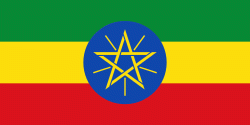Mizan Teferi (Mīzan Teferī)
Mizan Tefere (also called simply Mizan) is the largest town in South West Ethiopia Peoples' Region and one of four Capital cities of the region. Mizan is also the administrative centre, of the Bench Sheko Zone in the South West Ethiopia Peoples' Region of Ethiopia. Located about 160 kilometers southwest of Jimma, Mizan Tefere has a latitude and longitude of 7°N, 35.58333°W and an elevation of 1451 meters. Mizan Teferi, together with the neighbouring town of Aman, forms a separate woreda called Mizan Aman. This is surrounded by Debub Bench woreda.
Mizan Tefere is served by an airport (ICAO code HAMT, IATA MTF) with an unpaved runway. Until 1966, the town was connected by only a dry weather road to Gore; that year the roads to Bonga and Tepi were improved by the Highway Authority. Further proposed improvements were promised on 13 December 2006, when the Ethiopian government announced that it had secured a loan of US$98 million from the African Development Bank to pave the 227 kilometers of highway between Jimma and Mizan Teferi to the southwest. The loan would cover 64% of the 1270.97 million Birr budgeted for this project.
By 1996 there was 24-hour electricity, and access to potable water.
According to the SNNPR's Bureau of Finance and Economic Development, Mizan Teferi's amenities also include digital telephone access, postal service, and a bank and a hospital. Near the town is the Bebeka coffee plantation. It is also the location of two institutions of higher education, Aman Health Science College and Mizan - Tepi University.
Records at the Nordic Africa Institute website provide details of the primary and secondary school in 1968, and a 70-bed hospital built in 1989. During the existence of the Bench Zone (created in the mid-1990s) Mizan Teferi was its administrative center.
Mizan Tefere is served by an airport (ICAO code HAMT, IATA MTF) with an unpaved runway. Until 1966, the town was connected by only a dry weather road to Gore; that year the roads to Bonga and Tepi were improved by the Highway Authority. Further proposed improvements were promised on 13 December 2006, when the Ethiopian government announced that it had secured a loan of US$98 million from the African Development Bank to pave the 227 kilometers of highway between Jimma and Mizan Teferi to the southwest. The loan would cover 64% of the 1270.97 million Birr budgeted for this project.
By 1996 there was 24-hour electricity, and access to potable water.
According to the SNNPR's Bureau of Finance and Economic Development, Mizan Teferi's amenities also include digital telephone access, postal service, and a bank and a hospital. Near the town is the Bebeka coffee plantation. It is also the location of two institutions of higher education, Aman Health Science College and Mizan - Tepi University.
Records at the Nordic Africa Institute website provide details of the primary and secondary school in 1968, and a 70-bed hospital built in 1989. During the existence of the Bench Zone (created in the mid-1990s) Mizan Teferi was its administrative center.
Map - Mizan Teferi (Mīzan Teferī)
Map
Country - Ethiopia
 |
 |
| Flag of Ethiopia | |
Anatomically modern humans emerged from modern-day Ethiopia and set out to the Near East and elsewhere in the Middle Paleolithic period. Southwestern Ethiopia has been proposed as a possible homeland of the Afroasiatic language family. In 980 BCE, the Kingdom of D'mt extended its realm over Eritrea and the northern region of Ethiopia, while the Kingdom of Aksum maintained a unified civilization in the region for 900 years. Christianity was embraced by the kingdom in 330, and Islam arrived by the first Hijra in 615. After the collapse of Aksum in 960, a variety of kingdoms, largely tribal confederations, existed in the land of Ethiopia. The Zagwe dynasty ruled the north-central parts until being overthrown by Yekuno Amlak in 1270, inaugurating the Ethiopian Empire and the Solomonic dynasty, claimed descent from the biblical Solomon and Queen of Sheba under their son Menelik I. By the 14th century, the empire grew in prestige through territorial expansion and fighting against adjacent territories; most notably, the Ethiopian–Adal War (1529–1543) contributed to fragmentation of the empire, which ultimately fell under a decentralization known as Zemene Mesafint in the mid-18th century. Emperor Tewodros II ended Zemene Mesafint at the beginning of his reign in 1855, marking the reunification and modernization of Ethiopia.
Currency / Language
| ISO | Currency | Symbol | Significant figures |
|---|---|---|---|
| ETB | Ethiopian birr | Br | 2 |
| ISO | Language |
|---|---|
| AM | Amharic language |
| EN | English language |
| OM | Oromo language |
| SO | Somali language |
| TI | Tigrinya language |















